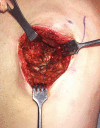Isolated Spinal Accessory Nerve Palsy from Volleyball Injury
- PMID: 35832161
- PMCID: PMC9142255
- DOI: 10.1055/s-0042-1748660
Isolated Spinal Accessory Nerve Palsy from Volleyball Injury
Abstract
Spinal accessory nerve (SAN) palsy is typically a result of posterior triangle surgery and can present with partial or complete paralysis of the trapezius muscle and severe shoulder dysfunction. We share an atypical case of a patient who presented with SAN palsy following an injury sustained playing competitive volleyball. A 19-year-old right hand dominant competitive volleyball player presented with right shoulder weakness, dyskinesia, and pain. She injured the right shoulder during a volleyball game 2 years prior when diving routinely for a ball. On physical examination she had weakness of shoulder shrug and a pronounced shift of the scapula when abducting or forward flexing her shoulder greater than 90 degrees. Manual stabilization of the scapula eliminated this shift, so we performed scapulopexy to stabilize the inferior angle of the scapula. At 6 months postoperative, she had full active range of motion of the shoulder. SAN palsy can occur following what would seem to be a routine volleyball maneuver. This could be due to a combination of muscle hypertrophy from intensive volleyball training and stretch sustained while diving for a ball. Despite delayed presentation and complete atrophy of the trapezius, a satisfactory outcome was achieved with scapulopexy.
Keywords: accessory nerve injuries; cranial nerve XI injury; spinal accessory nerve injury; spinal accessory nerve trauma.
The Korean Society of Plastic and Reconstructive Surgeons. This is an open access article published by Thieme under the terms of the Creative Commons Attribution-NonDerivative-NonCommercial License, permitting copying and reproduction so long as the original work is given appropriate credit. Contents may not be used for commercial purposes, or adapted, remixed, transformed or built upon. ( https://creativecommons.org/licenses/by-nc-nd/4.0/ ).
Conflict of interest statement
Conflict of Interest None declared.
Figures



References
-
- Rosse C, Gaddum-Rosse P. Philadelphia, PA: Lippincott Williams & Wilkins; 1997. Hollinshead's Textbook of Anatomy, 5th ed.
-
- Vastamäki M, Solonen K A. Accessory nerve injury. Acta Orthop Scand. 1984;55(03):296–299. - PubMed
-
- Eisen A, Bertrand G. Isolated accessory nerve palsy of spontaneous origin. A clinical and electromyographic study. Arch Neurol. 1972;27(06):496–502. - PubMed
-
- Sergides N N, Nikolopoulos D D, Polyzois I G. Idiopathic spinal accessory nerve palsy. A case report. Orthop Traumatol Surg Res. 2010;96(05):589–592. - PubMed
LinkOut - more resources
Full Text Sources

